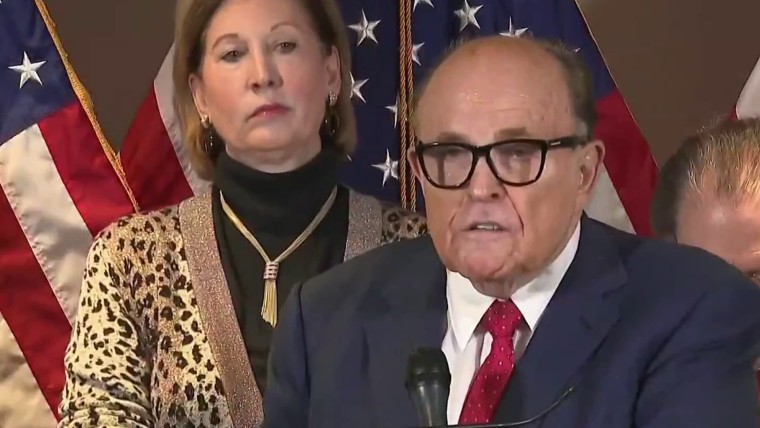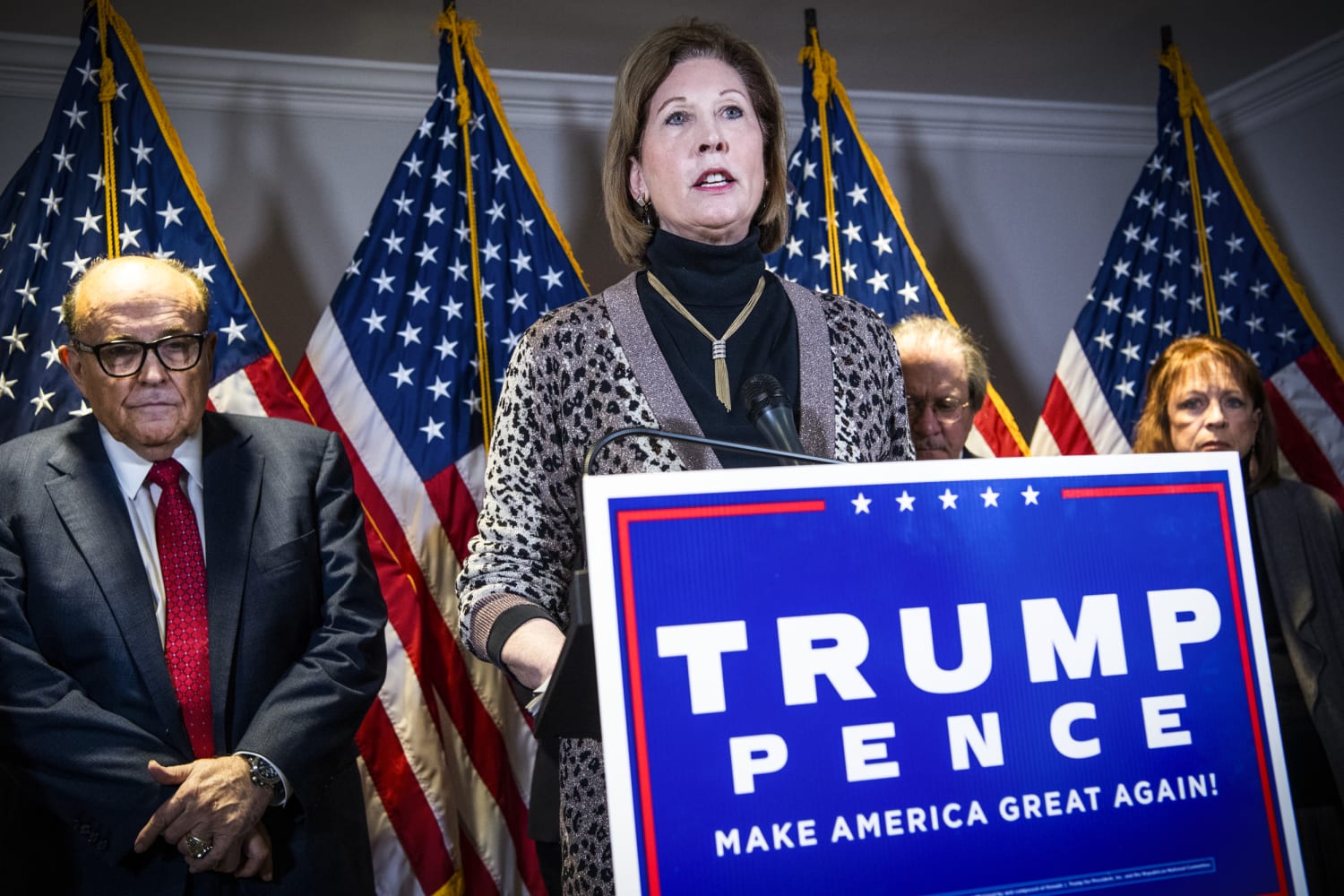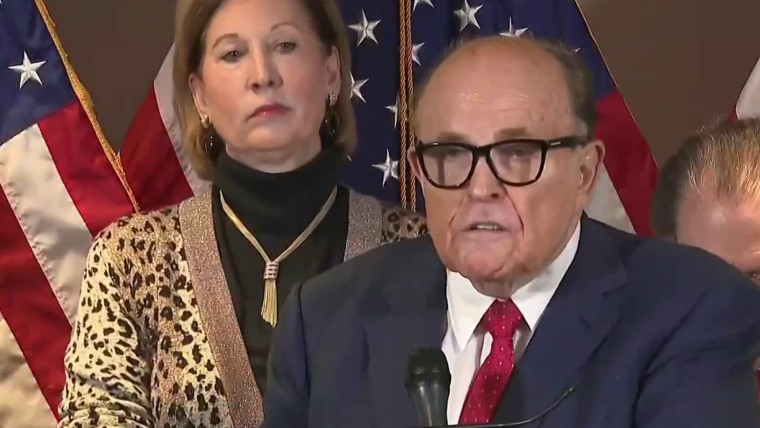WASHINGTON — The remarkable third indictment of former President Donald Trump returned by a federal grand jury on Tuesday includes six, un-named, un-indicted co-conspirators. But it also contains clues to their identities.
Five of the six alleged co-conspirators, based on details provided in transcripts of testimony to the Jan. 6 Committee and other records, appear to be: Former New York City Mayor and longtime Trump attorney Rudy Giuliani; lawyer John Eastman, who spoke at the Jan. 6 rally and helped architect the “fake electors scheme“; attorney Sidney Powell, who helped lead Trump’s post-campaign legal efforts and promoted conspiracy theories; former Justice Department official Jeffrey Clark, whom Trump considered making his attorney general; and Kenneth Chesebro, another attorney pushing the “fake electors scheme.”
It is not clear who co-conspirator 6 is.
Prosecutors typically don’t name alleged co-conspirators who have not yet been charged with any crimes.
Co-Conspirator 1
The indictment says that co-conspirator 1 is an “attorney who was willing to spread knowingly false claims and pursue strategies that the Defendant’s 2020 re-election campaign attorneys would not.” The details in the indictment appear to line up with Rudy Giuliani, his attorney acknowledged in a statement Tuesday.
The indictment quotes co-conspirator 1 using “words to the effect of, ‘We don’t have the evidence, but we have lots of theories'” in December 2020. Arizona House Speaker Rusty Bowers attributed a similar quote to Giuliani on the record in the Jan. 6 House Select Committee’s fourth public hearing.
Giuliani recently conceded that he made “false” statements about two Georgia 2020 election workers, Ruby Freeman and her daughter Wandrea “Shaye” Moss, when he accused them of “surreptitiously passing around USB ports as if they are vials of heroin or cocaine” in a video. (In fact, they were passing a ginger mint.) The indictment quotes Giuliani’s attacks on the mother-daughter duo, and notes that they “received numerous death threats.” Justice Department officials advised Trump that the video that Giuliani had shown of Moss and Freeman was “benign,” according to the indictment.
“It appears that this indictment alleges that Mayor Giuliani is co-conspirator #1,” Giuliani attorney Robert Costello said Tuesday. “This indictment eviscerates the First Amendment and tries to criminalize the existing administration’s number one political opponent for daring to challenge the election results of 2020.” (The indictment states that Trump had “a right” to “claim, falsely, that there had been outcome-determinative fraud during the election and that he had won” but alleges that Trump also pursued criminal conspiracies and “unlawful means of discounting legitimate votes and subverting the election results” that “targeted a bedrock function of the United States federal government: the nation’s process of collecting, counting, and certifying the results of the presidential election.”)
Co-Conspirator 2
John Eastman is unindicted co-conspirator 2, according to his attorney, Harvey Silverglate, who said he plans to send a memo to the special counsel explaining why Eastman is innocent.
The indictment describes co-conspirator 2 as “an attorney who devised and attempted to implement a strategy to leverage the Vice President’s ceremonial role overseeing the electoral certification proceeding to obstruct the certification of the presidential election.”
Co-Conspirator 3
The person identified as co-conspirator 3 — who the indictment says is an attorney whose unfounded claims of election fraud Trump “privately acknowledged to others sounded ‘crazy'” — appears to be Sidney Powell. Trump, according to the indictment, “embraced and publicly amplified Co-Conspirator 3’s disinformation.”
A lawsuit filed by Powell is referenced in the indictment. Powell’s lawsuit and its subsequent dismissal were publicly reported on at the time. And Trump’s statement that Powell sounded “crazy” was part of the Jan. 6 Committee’s final report, which said that Trump “muted his speakerphone and laughed at Powell, telling the others in the room, ‘This does sound crazy, doesn’t it?'”
NBC News has reached out to Powell’s attorney for comment.
Co-Conspirator 4
The person identified as co-conspirator 4 appears to be Jeffrey Clark. For example, the indictment identifies the person as a Justice Department official who met with Trump at the White House on December 22. “Co-Conspirator 4 had not informed his leadership at the Justice Department of the meeting, which was a violation of the Justice Department’s written policy restricting contacts with the White House to guard against improper political influence. On December 26, Co-Conspirator 4 spoke on the phone with the Acting Attorney General and lied about the circumstances of his meeting with the Defendant” — referring to Trump — “at the White House, falsely claiming that the meeting had been unplanned. The Acting Attorney General directed Co-Conspirator 4 not to have unauthorized contacts with the White House again, and Co-Conspirator 4 said he would not.”
The Jan. 6 Committee’s final report cited Clark’s Dec. 22 meeting with Trump and also noted that it was strictly against DOJ policy. The committee also stated that Acting Attorney General Rosen spoke to Clark by phone on Dec. 26. According to the report, Clark’s meeting with Trump and Rep. Scott Perry, R-Pa., “on December 22nd was a clear violation of Department policy, which limits interactions between the White House and the Department’s staff.”
Clark’s lawyer did not immediately respond to a request for comment.
Co-Conspirator 5
The person identified as co-conspirator 5 appears to be Kenneth Chesebro. The indictment described co-conspirator 5 as “an attorney who assisted in devising and attempting to implement a plan to submit fraudulent slates of presidential electors to obstruct the certification proceeding.”
The Jan. 6 Committee’s report specifically named Chesebro as the person who created “step by step” instructions for fake electors to follow, including in a memo penned by Chesebro on Dec. 9.
The indictment also states that co-conspirator 5 called an Arizona attorney on Dec. 8, writing that the attorney subsequently wrote an email outlining the conversation he had with the caller about the fake electors’ strategy (That email is reproduced in the indictment.) The New York Times reported on that same email on July 26, 2022, naming Chesebro as the person who floated the theory.
A representative for Chesebro did not immediately respond to a request for comment.
Source: | This article originally belongs to Nbcnews.com














